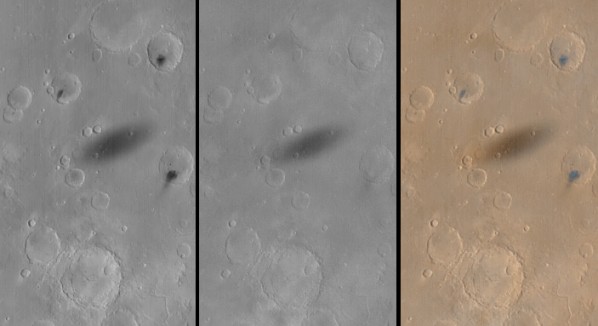Skip to comments.
Astronomy Picture of the Day 3-29-03
NASA ^
| 3-29-03
| Robert Nemiroff and Jerry Bonnell
Posted on 03/28/2003 9:58:32 PM PST by petuniasevan
Astronomy Picture of the Day
Discover the cosmos! Each day a different image or photograph of our fascinating universe is featured, along with a brief explanation written by a professional astronomer. 2003 March 29

The Shadow of Phobos
Credit: Malin Space Science Systems, MGS, JPL, NASA
Explanation: Hurtling through space above the Red Planet, potato-shaped Phobos completes an orbit of Mars in less than eight hours. In fact, since its orbital period is shorter than the planet's rotation period, Mars-based observers see Phobos rise in the west and set in the east - traveling from horizon to horizon in about 5 1/2 hours. These three images from the Mars Global Surveyor (MGS) spacecraft record the oval shadow of Phobos racing over western Xanthe Terra on August 26, 1999. The area imaged is about 250 kilometers across and is seen in panels from left to right as red filter, blue filter, and combined color composite views from the MGS wide-angle camera system. The three dark spots most easily seen in the red filter image are likely small fields of dark sand dunes on crater floors. Standing in the shadow of Phobos, you would see the Martian version of a solar eclipse!
TOPICS: Astronomy; Astronomy Picture of the Day; Science
KEYWORDS: astronomy; bodeslaw; crater; deimos; global; grooves; image; mars; martian; phobos; photography; rochelimit; rocheradius; shadow; stickneycrater; striations; surface; surveyor; titiusbode; titiusbodelaw; titiusbodeslaw; xanthe
Phobos orbits Mars at an altitude of only about 3000 miles! Not only that, but it orbits in a
retrograde motion. This is not a stable orbit in the long term. It loses about 6 feet in altitude per century; Phobos may one day reach the
Roche limit and break up, perhaps forming a ring. Or else it may slam into Mars, with catastrophic results.
If you were on Mars near its equator, you would see Phobos cross the sky three times a day! If you were in one of the polar regions, Phobos would be below the horizon.
Both Phobos and Deimos seem to be captured asteroids.
The giant crater which dominates Phobos is called Stickney.

Here are Phobos' "vital statistics"
| Phobos Statistics |
| Discovered by |
Asaph Hall |
| Date of discovery |
1877 |
| Mass (kg) |
1.08e+16 |
| Mass (Earth = 1) |
1.8072e-09 |
| Radius (km) |
13.5x10.8x9.4 |
| Radius (Earth = 1) |
2.1167e-03 |
| Mean density (gm/cm^3) |
2.0 |
| Mean distance from Mars (km) |
9,380 |
| Rotational period (days) |
0.31910 |
| Orbital period (days) |
0.31910 |
| Mean orbital velocity (km/sec) |
2.14 |
| Orbital eccentricity |
0.01 |
| Orbital inclination (degrees) |
1.0 |
| Escape velocity (km/sec) |
0.0103 |
| Visual geometric albedo |
0.06 |
| Magnitude (Vo) |
11.3 |
To: MozartLover; Joan912; NovemberCharlie; snowfox; Dawgsquat; viligantcitizen; theDentist; ...
2
posted on
03/28/2003 9:59:35 PM PST
by
petuniasevan
(Wonders of the Universe)
To: petuniasevan
So, what would Phobos appear like to observers watching its transit every day? Would it appear like a star in the sky? could you even see it?
3
posted on
03/28/2003 10:27:53 PM PST
by
BradyLS
To: petuniasevan
Add me to your Ping list plz :)
To: SShultz460
Will do.

5
posted on
03/28/2003 10:46:28 PM PST
by
petuniasevan
(Wonders of the Universe)
To: BradyLS
You'd still see it, but it would appear only 20% of the size of Earth's moon. Plus it is irregular in shape so its phases would appear strange. Its albedo is very low; Earth's moon reflects twice as much light. Still, it would be obvious even to a casual observer.
6
posted on
03/28/2003 10:54:24 PM PST
by
petuniasevan
(Wonders of the Universe)
To: petuniasevan
Oh my gosh, I have never even heard of Phobos! Thanks for the info! :)
7
posted on
03/29/2003 8:10:23 AM PST
by
Joan912
(i'm speechless)
To: petuniasevan
Thanks for the answer! Can anyone recall any SF stories set on Mars that evens mentions its moons in its sky?
8
posted on
03/29/2003 8:58:22 AM PST
by
BradyLS
To: BradyLS
I suppose you mean "classic" sci-fi.
How about Edgar Rice Burroughs' famed "Barsoom" series?
Under the moons of Mars is the title of one.
If you include modern, there's lots of novels, novellas, short stories, etc.
Try Kim Stanley Robinson's trilogy: Red Mars, Green Mars, and Blue Mars.
9
posted on
03/29/2003 9:58:10 PM PST
by
petuniasevan
(Wonders of the Universe)
Disclaimer:
Opinions posted on Free Republic are those of the individual
posters and do not necessarily represent the opinion of Free Republic or its
management. All materials posted herein are protected by copyright law and the
exemption for fair use of copyrighted works.
FreeRepublic.com is powered by software copyright 2000-2008 John Robinson


